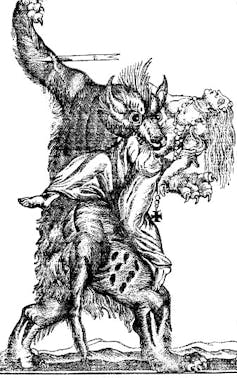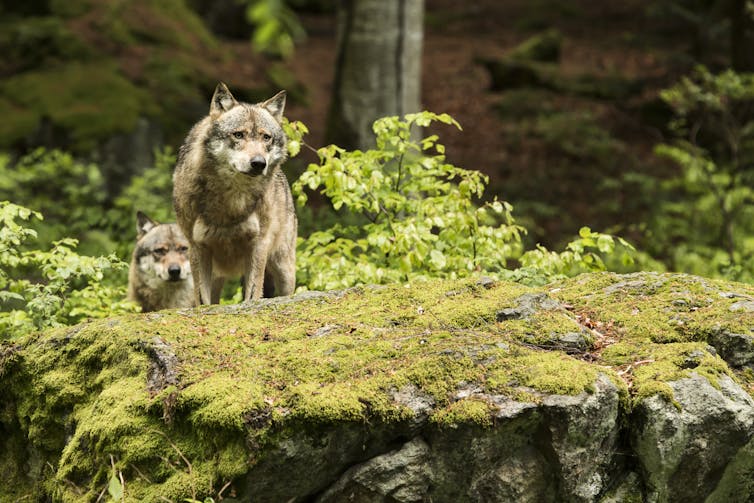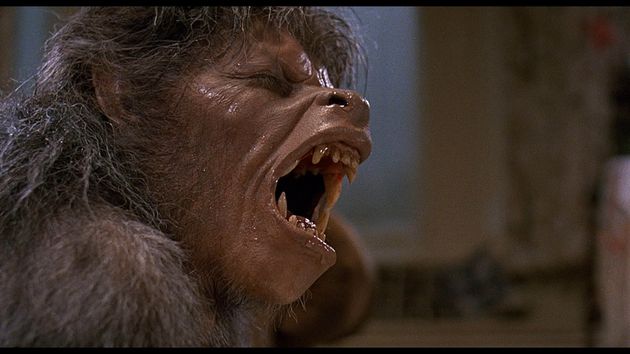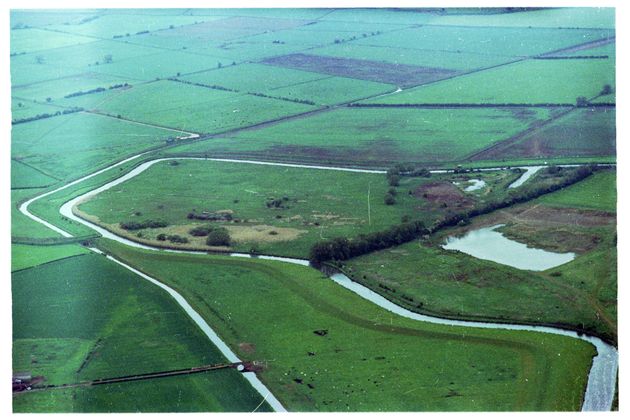Sam M George
This essay started life as a paper for the Manchester Gothic Festival and was adapted for the Supernatural Cities Conference in Limerick 2017. It is now destined for a special OGOM edition of Gothic Studies, 'Wolves, Werewolves and Wilderness' to be published in the spring of 2018.
In 1865, Sabine Baring-Gould (1834-1924) argued that ‘English folklore is singularly barren of werewolf stories, the reason being that wolves had been extirpated from England under the Anglo Saxon Kings, and therefore ceased to be objects of dread to the people’.
The Dictionary of English Folklore similarly informs us that ‘there are no werewolf tales in English folklore, presumably because wolves have been extinct here for centuries’.
These longstanding assumptions make the present day sightings of the English werewolf known as‘Old Stinker’ all the more unusual. What is most pertinent about this latest folk panic is that‘Old Stinker’ inhabits a landscape which is thought to have accommodated some of the last wolves in England. These sightings coincide with a phase of severe environmental damage.This has not taken the form of sudden catastrophe, but rather a slow grinding away of species.The result is a contemporary landscape constituted more actively by what is missing than by what is present, a spectred, rather than ‘a scepter’d isle’.The Victorian novelist Emily Gerard (1849-1905) explained the Romanian belief in the werewolf by associating it with a continuing fear of the wolf: ‘it is safe to prophesy that as long as the flesh-and-blood wolf continues to haunt the Transylvanian forests, so long will his spectre brother survive in the minds of the people’.
The emergence of an English werewolf (‘Old Stinker’) in Hull in the present day has reopened debates about the spectre werewolf’s relationship to the ‘flesh-and-blood’ wolf. In this article, I depart from the earlier opinions of Emily Gerard, Sabine Baring-Gould, and others, who explained the disappearance of the werewolf in folklore as following the extinction of the wolf. I argue instead that British literature is distinctive in representing a history of werewolf sightings in places in Britain where there were once wolves. I draw on the idea of absence, manifestations of the English eerie, and the turbulence of England in the era of late capitalism to illuminate my analysis of the representation of contemporary werewolf sightings.I
In literature, accounts of werewolfism or lycanthropy can be traced back to the epic of
Gilgamesh in approximately 2000 BC, whereas early fables warning of the wolf are exemplified by Aesop’s ‘The Boy Who Cried Wolf’ in 620-520 BC. Virgil’s Eclogues are thought to be the first account of voluntary werewolfism (around 42-39 BC). 1589, the year that saw the rise of werewolf trials in France, appears to have been the werewolf’s annusmirabilis. (A WELL DONE PUN)
Jean Grenier, the ‘Werewolf of Chalons’, and the Gandillon family, all of whom were executed as werewolves at this time, were murderers who had a taste for human flesh.The story of Grenier, a werewolf boy who supposedly fell upon and devoured several children, is recounted in Sabine Baring-Gould’s book on Werewolves (1865).
The boy claimed to be under the control of the ‘Lord of the Forest’ (THE GREEN MAN/CERNUNNOS/PAN) and was said to have appeared to his victims in wolf form.
Sorcery is the key to understanding such happenings, according to Baring Gould’s explanation of werewolfism. Such notions endured into the early twentieth century. Montague Summers (1880-1948) posited a shared history of witches and werewolves, shown through his use of demonologies in The Werewolf in Lore and Legend (1933). We are reminded that James I’s Daemonologie (1597), used widely in witchcraft trials, acknowledges the existence of ‘Men-Woolfes’.
British witchcraft trials focused on the witch’s metamorphosis into hare or cat, paralleling the preoccupation with shape shifting in European werewolf trials.Summers perpetuates this association between witches and werewolves in the twentieth century by documenting the historical sources and the authorities on shape shifting witches in England, Wales, Scotland, and Ireland and by appending material on ‘witch ointments’ to his study of the werewolf.

Sabine Baring-Gould (1834-1924) was a Vicar in the Church of England in Devon, an archaeologist, folklorist, historian and a prolific author. Baring-Gould was also a bit eccentric. He reputedly taught classes with a pet bat on his shoulder. (SNIPE OF HOUSE SLITHERN HOGWARTS) He is best known for writing the hymn 'Onward Christian Soldiers'.
This book is one of the most cited references about werewolves. The Book of the Were-Wolf takes a rationalistic approach to the subject.
The book starts off with a straightforward academic review of the literature of shape-shifting; however, starting with Chapter XI, the narrative takes a strange turn into sensationalistic 'true crime' case-studies of cannibals, grave desecrators, and blood fetishists, which have a tenuous connection with lycanthropy. This includes an extended treatment of the case of Giles de Rais, the notorious associate of Joan of Arc, who was convicted and executed for necrosadistic crimes. Margaret Murray had a controversial theory about this subject. (SO DID ALEISTER CROWLEY, OF COURSE)
Nevertheless, the first ten chapters of this book constitute an essential work on the subject of werewolves. This etext was scanned at sacred-texts.
Why we should welcome the return of ‘Old Stinker’, the English werewolf
Over the last few months there has been something of a folk panic in Yorkshire, northern England, following reported sightings of an eight-foot werewolf with a very human face.
The werewolf “Old Stinker”, also known as “The Beast of Barmston Drain” is not a recent phenomenon – it was first reported in the 18th century. But these sightings – concentrated around the town of Hull – are especially intriguing considering that English folklore is rather barren of werewolf stories. Most wolves were extirpated from England under the Anglo-Saxon kings and so ceased to be an object of dread to the people (though wolves did in fact survive in the UK up until the 1500s). So what could be behind these new werewolf sightings?
In literature, accounts of lycanthropy – humans transforming into werewolves – can be traced back to the epic of Gilgamesh in 2100BC, whereas wolf fables begin with Aesop’s The Boy Who Cried Wolf, which was written at some point between 620 and 520 BC. Voluntary lycanthropy does appear from time to time – Virgil’s Eclogues are thought to be the first such account (42-39 BC), but becoming a werewolf is more commonly seen as “a curse” or a sign of bestiality, or at worst of cannibalism.

A werewolf devouring a woman. From a XIX c. engraving. Mansell Collection, London.
Most people have heard of witchcraft trials but werewolf trials are less well known – and those who were executed in werewolf trials in 16th and 17th-century France were believed to have a taste for human flesh. But these cannibalistic fears died down with the rise of psychoanalysis in the 19th century, when lycanthropy came to more commonly represent the “beast within” or everything animal that we have repressed in terms of our human nature.
History, then, provides us with two possible answers as to why people might think they’ve spotted werewolves in the English countryside. The first is a fear of violence, manifesting in anxieties around cannibalism. The second is a return of the repressed (perhaps the population of Hull are having a particularly Freudian spell?).
Needless to say, I cannot support these theories. I would argue instead that the answer lies in our cultural understanding of the werewolf and its connection to our native wolves. By reconsidering these primal links, we can begin to understand why people think they see werewolves – and this is pertinent to the appearance of Old Stinker himself.
Were(wolves)
It is important to consider the werewolf as the spectre brother or shadow self of the wolf and to perceive the history of lycanthropy as being inextricably bound up with humankind’s treatment of wolves. For example, the case of Peter Stumpf, who was executed in Germany for being a werewolf in 1589, gained much noteriety in 16th-century Britain. It is notable that this interest corresponds with the extinction of the wolf in England in the 1500s.
Back to today. In 2015 the Open Graves, Open Minds project hosted the first international conference on werewolves at the University of Hertfordshire. This research drew attention to attempts to rewild the wolf in the UK and scholars began to question what would happen if wolves returned to our forests, as was prominent in associated media reports.
Our collaborations with the UK Wolf Trust generated further discussions around the possibility of rewilding large species in Britain including wolves and lynx. It is in this climate that new sightings of the Hull werewolf had begun to appear.
Most people have heard of witchcraft trials but werewolf trials are less well known – and those who were executed in werewolf trials in 16th and 17th-century France were believed to have a taste for human flesh. But these cannibalistic fears died down with the rise of psychoanalysis in the 19th century, when lycanthropy came to more commonly represent the “beast within” or everything animal that we have repressed in terms of our human nature.
History, then, provides us with two possible answers as to why people might think they’ve spotted werewolves in the English countryside. The first is a fear of violence, manifesting in anxieties around cannibalism. The second is a return of the repressed (perhaps the population of Hull are having a particularly Freudian spell?).
Needless to say, I cannot support these theories. I would argue instead that the answer lies in our cultural understanding of the werewolf and its connection to our native wolves. By reconsidering these primal links, we can begin to understand why people think they see werewolves – and this is pertinent to the appearance of Old Stinker himself.
Were(wolves)
It is important to consider the werewolf as the spectre brother or shadow self of the wolf and to perceive the history of lycanthropy as being inextricably bound up with humankind’s treatment of wolves. For example, the case of Peter Stumpf, who was executed in Germany for being a werewolf in 1589, gained much noteriety in 16th-century Britain. It is notable that this interest corresponds with the extinction of the wolf in England in the 1500s.
Back to today. In 2015 the Open Graves, Open Minds project hosted the first international conference on werewolves at the University of Hertfordshire. This research drew attention to attempts to rewild the wolf in the UK and scholars began to question what would happen if wolves returned to our forests, as was prominent in associated media reports.
Our collaborations with the UK Wolf Trust generated further discussions around the possibility of rewilding large species in Britain including wolves and lynx. It is in this climate that new sightings of the Hull werewolf had begun to appear.

Who wants to re-wolf Britain? Nadezda Murmakova/Shutterstock
In July of this year newspapers reported that Old Stinker was terrorising women with his human face and very, very, bad breath (hence his name). The two most recent sightings were reported on in August: “Woman met eight-foot werewolf with human face” proclaimed the Metro newspaper. A full-scale werewolf hunt ensued after Old Stinker was spotted prowling an industrial estate. The werewolf had apparently eaten a German Shepherd dog and was seen leaping over fences like a modern day Spring-Heeled Jack (the folk devil that plagued Victorian London).
Wolf guilt
Importantly, Old Stinker supposedly inhabits a landscape that is thought to have seen some of the last UK wolves. So the emergence of the Hull werewolf can reopen debates about the spectre werewolf’s relationship to the flesh and blood wolf. This coincides with a phase of severe environmental damage. It has not taken the form of sudden catastrophe, but rather a slow grinding away of species. The result is a landscape constituted more actively by what is missing than by what is present, a “spectred”, rather than “a sceptered isle”. He represents not only a nation’s belief in him as a supernatural shapeshifter, but its collective guilt at the extinction of an entire indigenous species of wolf.
Far from dismissing the myth, my instincts are to embrace it and see it as a response to our cultural memory around what humans did to wolves.
The Old Stinker story tells us that belief in werewolves lives on beyond the actual lives of the wolves that were thought to inspire them. Rather than being dismissed as a rather fishy tale, Old Stinker can activate the wolf warrior in all of us and allow us to lament the last wolves that ran free in English forests. Far from being a curse, he is a gift: he can initiate rewilding debates and redeem the big bad wolf that filled our childhood nightmares, reminding us that it is often humans, not wolves or the supernatural, that we should be afraid of.
In July of this year newspapers reported that Old Stinker was terrorising women with his human face and very, very, bad breath (hence his name). The two most recent sightings were reported on in August: “Woman met eight-foot werewolf with human face” proclaimed the Metro newspaper. A full-scale werewolf hunt ensued after Old Stinker was spotted prowling an industrial estate. The werewolf had apparently eaten a German Shepherd dog and was seen leaping over fences like a modern day Spring-Heeled Jack (the folk devil that plagued Victorian London).
Wolf guilt
Importantly, Old Stinker supposedly inhabits a landscape that is thought to have seen some of the last UK wolves. So the emergence of the Hull werewolf can reopen debates about the spectre werewolf’s relationship to the flesh and blood wolf. This coincides with a phase of severe environmental damage. It has not taken the form of sudden catastrophe, but rather a slow grinding away of species. The result is a landscape constituted more actively by what is missing than by what is present, a “spectred”, rather than “a sceptered isle”. He represents not only a nation’s belief in him as a supernatural shapeshifter, but its collective guilt at the extinction of an entire indigenous species of wolf.
Far from dismissing the myth, my instincts are to embrace it and see it as a response to our cultural memory around what humans did to wolves.
The Old Stinker story tells us that belief in werewolves lives on beyond the actual lives of the wolves that were thought to inspire them. Rather than being dismissed as a rather fishy tale, Old Stinker can activate the wolf warrior in all of us and allow us to lament the last wolves that ran free in English forests. Far from being a curse, he is a gift: he can initiate rewilding debates and redeem the big bad wolf that filled our childhood nightmares, reminding us that it is often humans, not wolves or the supernatural, that we should be afraid of.
Sam George
Senior Lecturer in Literature, University of Hertfordshire
Disclosure statement
Sam George does not work for, consult, own shares in or receive funding from any company or organisation that would benefit from this article, and has disclosed no relevant affiliations beyond their academic appointment.
Senior Lecturer in Literature, University of Hertfordshire
Disclosure statement
Sam George does not work for, consult, own shares in or receive funding from any company or organisation that would benefit from this article, and has disclosed no relevant affiliations beyond their academic appointment.
‘Truth’ behind those sightings of Hull’s Beast of Barmston Drain werewolf

An American Werewolf in Hull? Published: Friday 21 October 2016
Collective guilt about wiping out the native wolf population could be cause behind the sightings of “Old Stinker” in Hull, according to an academic.
Media round the world picked up on claims that a “half-man, half-dog” creature had been spotted stalking the banks of the city’s Barmston Drain earlier this year.

Barmston Drain in Hull: Could this be the home of 'Old Stinker'?
There were lurid reports of the “tall and hairy” beast being seen gobbling a German Shepherd and then jumping 8ft over a fence - with its prey still in its jaws.
The creature, dubbed the “Beast of Barmston Drain” was connected by folklorists to the legend of “Old Stinker”, a werewolf said to stalk the Yorkshire Wolds.
Further sightings followed - including in August when a woman in a car with friends claimed she saw a beast with a human head started walking towards them on two legs on a road through the East Yorkshire village of Halsham.
The location of the sightings, close to the East Yorkshire Wolds, which were once home to wolves, could be significant, according to Dr Sam George, a gothic scholar and literary expert.
Dr George, who was behind the UK’s first International Werewolf Conference at the University of Hertfordshire last year, said: “I often get asked what causes belief in werewolfism, but what is most pertinent and magical about this latest folk panic is that “‘Old Stinker’ is thought to inhabit a landscape which saw some of the last wolves in England.
“I argue that he represents, not our belief in him as a supernatural shapeshifter, but our collective guilt at the extinction of an entire indigenous species.”
Far from dismissing it as a figment of the imagination, Dr George says it’s important to explore people’s fears and look for deeper meanings, adding: “My instincts are to embrace it and see it as a manifestation of our cultural memory around wolves.
“‘Old Stinker’ is a gift; he can reawaken the memory of what humans did to wolves, draw attention to re-wilding debates, and redeem the big bad wolf that filled our childhood nightmares, reminding us that it is often humans, not wolves or the supernatural, that we should be afraid of.”
The sightings led to a freedom of information request to Hull Council which confirmed it had no policy on werewolves and rock legend Alice Cooper to ask: “So there are suddenly several reports of a werewolf like creature near a small town in the UK. Do you think it could be real?”
NEWS
16/05/2016
8ft Tall Werewolf ‘Old Stinker’ Prowling In Hull Industrial Estate
By Sara C Nelson
An 8ft tall hairy creature which can stand upright like a man is said to be prowling a derelict industrial area just outside of Hull.
An 8ft tall hairy creature which can stand upright like a man is said to be prowling a derelict industrial area just outside of Hull.
One eye-witness claims to have seen the “half-man, half-dog” lurking around the banks of Barmston Drain at Christmas and since then there have six further reported sightings
A woman told the Express: “It was stood upright one moment. The next it was down on all fours running like a dog. I was terrified.

.A 'half-man half-wolf' beast is rumoured to be prowling an abandoned industrial estate just outside of Hull. Pictured is a still from the 1981 film An American Werewolf in London
“It bounded along on all fours, then stopped and reared up on its back legs, before running down the embankment towards the water.
“It vaulted 30ft over to the other side and vanished up the embankment and over a wall into some allotments.”
Another person told the Hull Daily Mail they had seen something “tall and hairy” jump over an 8ft fence, carrying a German Shepherd in its jaws.
The sightings have been linked to the local legend of a werewolf called Old Stinker, described by author Charles Christian as “a great hairy beast with red eyes, who was so-called because he had bad breath.”

ALAMY
The beast was allegedly spotted at Barmston Drain at Christmas
The legend was borne because that part of the country was once infested with wolves, Christian explains, pointing out that up until the 18th century there was still a bounty for anyone killing them.
“It was known for the wolves to dig up the corpses from graveyards. From that sprung the idea that they are supernatural beings, who took the form of werewolves,” he told the Hull Daily Mail.
Paranormal investigator Lee Brickely told Huffington Post UK: "It's a case I'm following closely, and it certainly raises many issues relating to the existence of werewolves in the UK.
"For the time being, I'd like to see more evidence and reports from locals."

Wolf bounties were offered during the 18th century (file picture)
Brickley, who is the author of UFOs, Werewolves & The Pig-Man, added: "As most people are aware, my home turf Cannock Chase is renowned for such encounters, and I'd most definitely like to investigate this case further. It appears, yet again, that there are many similarities within the sighting reports, and so I wouldn't rule this out as being a genuine paranormal encounter.
"Whether people believe werewolves are flesh and blood creatures or just beastly apparitions is another matter entirely."
But despite the 'evidence', Christian is sceptical that Old Stinker is back on the prowl.
Speaking to Huffington Post UK he said the animal is more likely to be “some feral creature living there that has got large and shaggy – like a big dog.”

ANDREW MILLIGAN/PA WIRE
The legend was borne because that part of the country was once infested with wolves, Christian explains, pointing out that up until the 18th century there was still a bounty for anyone killing them.
“It was known for the wolves to dig up the corpses from graveyards. From that sprung the idea that they are supernatural beings, who took the form of werewolves,” he told the Hull Daily Mail.
Paranormal investigator Lee Brickely told Huffington Post UK: "It's a case I'm following closely, and it certainly raises many issues relating to the existence of werewolves in the UK.
"For the time being, I'd like to see more evidence and reports from locals."

Wolf bounties were offered during the 18th century (file picture)
Brickley, who is the author of UFOs, Werewolves & The Pig-Man, added: "As most people are aware, my home turf Cannock Chase is renowned for such encounters, and I'd most definitely like to investigate this case further. It appears, yet again, that there are many similarities within the sighting reports, and so I wouldn't rule this out as being a genuine paranormal encounter.
"Whether people believe werewolves are flesh and blood creatures or just beastly apparitions is another matter entirely."
But despite the 'evidence', Christian is sceptical that Old Stinker is back on the prowl.
Speaking to Huffington Post UK he said the animal is more likely to be “some feral creature living there that has got large and shaggy – like a big dog.”

ANDREW MILLIGAN/PA WIRE
Could the animal be pet Husky that has been left to go feral?
Musing that it is likely to be a large breed that has been let go by owners who can no longer care for, Christian guesses it could be a Japanese Akita or a Husky.
“There has been a fashion for Huskies as pets and they grow enormous. The area where this animal is being sighted is semi-derelict and filled with abandoned warehouses and factories – an idea shelter for it," he said.
Christian, who is the author of A Travel Guide to Yorkshire's Wild Wolds added: “I wouldn’t advise stocking up silver bullets just yet. But I would advise against going out in the area by yourself without a big stick.”
Nonetheless, Hull historian Mike Covell has organised a nighttime “werewolf hunt” during the next full moon.
Covell said: "The idea is to visit the drain and walk along it armed with recording equipment. It has attracted a lot of interest and although people are taking it with a pinch of salt, they are fascinated by the reports."
He might want to keep Christian’s advice in mind. Just in case.
Musing that it is likely to be a large breed that has been let go by owners who can no longer care for, Christian guesses it could be a Japanese Akita or a Husky.
“There has been a fashion for Huskies as pets and they grow enormous. The area where this animal is being sighted is semi-derelict and filled with abandoned warehouses and factories – an idea shelter for it," he said.
Christian, who is the author of A Travel Guide to Yorkshire's Wild Wolds added: “I wouldn’t advise stocking up silver bullets just yet. But I would advise against going out in the area by yourself without a big stick.”
Nonetheless, Hull historian Mike Covell has organised a nighttime “werewolf hunt” during the next full moon.
Covell said: "The idea is to visit the drain and walk along it armed with recording equipment. It has attracted a lot of interest and although people are taking it with a pinch of salt, they are fascinated by the reports."
He might want to keep Christian’s advice in mind. Just in case.
No comments:
Post a Comment